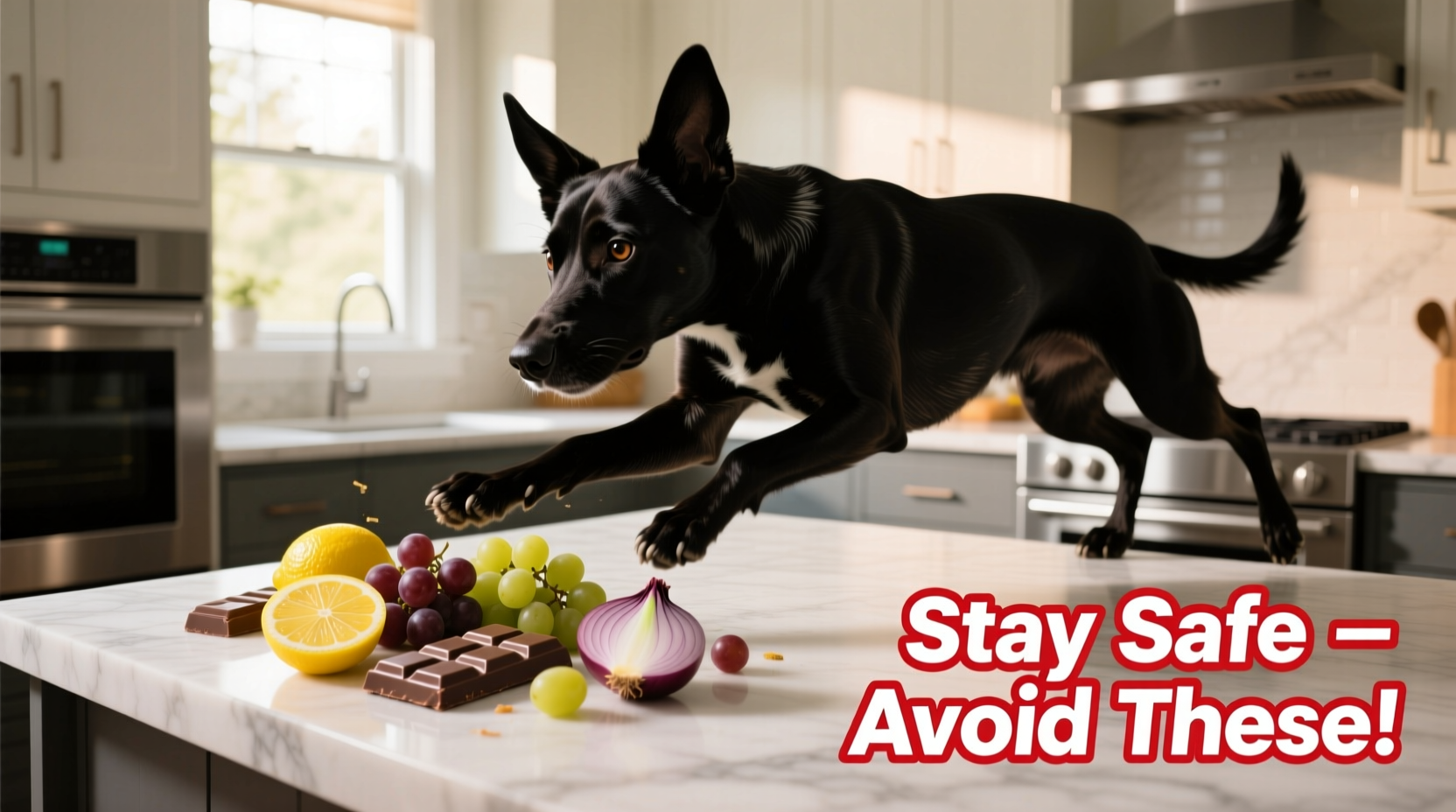Essential Guide to Foods Dogs Must Never Eat
As a dog owner, knowing which human foods pose serious health risks to your pet is critical for their safety. While dogs might beg for table scraps, many common household foods contain compounds that can cause anything from mild stomach upset to life-threatening conditions. This guide provides vet-verified information about dangerous foods, organized by risk level to help you protect your furry family member.

Top 3 Most Dangerous Foods for Dogs
1. Chocolate and Caffeine
Chocolate contains theobromine and caffeine, which dogs metabolize much more slowly than humans. Dark chocolate and baking chocolate contain higher concentrations and pose the greatest risk.
Symptoms appear within 6-12 hours and include vomiting, diarrhea, rapid breathing, increased heart rate, tremors, and seizures. Severe cases can lead to cardiac arrhythmias or death.
Minimum toxic dose: As little as 20mg of theobromine per kilogram of body weight. For a 20-pound dog:
| Chocolate Type | Minimum Toxic Amount |
|---|---|
| Milk Chocolate | 1 ounce per pound of body weight |
| Dark Chocolate | 0.1 ounce per pound of body weight |
| Baking Chocolate | 0.05 ounce per pound of body weight |
According to the ASPCA Animal Poison Control Center, chocolate poisoning accounts for approximately 10% of all pet poison cases reported annually.
2. Xylitol
This artificial sweetener found in sugar-free gum, candy, baked goods, and some peanut butter brands causes a dangerous insulin release in dogs, leading to hypoglycemia (low blood sugar) within 10-60 minutes of ingestion.
What makes xylitol particularly dangerous: Even small amounts can be fatal. As little as 0.1 grams per kilogram of body weight can cause hypoglycemia, while 0.5 grams per kilogram can cause liver failure.
Symptoms include: Vomiting, weakness, loss of coordination, collapse, and seizures. Liver damage may develop 24-48 hours after ingestion.
The Cornell University College of Veterinary Medicine reports that xylitol poisoning cases have increased dramatically as more products incorporate this sweetener.
3. Grapes and Raisins
The exact toxic compound in grapes and raisins remains unidentified, but ingestion can cause acute kidney failure in dogs. The toxicity doesn't appear dose-dependent—some dogs show symptoms after eating just a few grapes.
Symptoms typically appear within 6-12 hours and include vomiting, diarrhea, abdominal pain, and decreased urine production. Without prompt treatment, kidney failure can develop within 48 hours.
According to research published in the Journal of the American Veterinary Medical Association, the minimum toxic dose is approximately 19-30 grams of grapes per kilogram of body weight.
Moderate Risk Foods: Handle with Extreme Caution
Onions, Garlic, and Other Alliums
These contain thiosulfate compounds that damage red blood cells, leading to hemolytic anemia. All forms (raw, cooked, powdered) are dangerous.
Risk factors: Smaller dogs are more vulnerable, and toxicity is cumulative—repeated small exposures can be as dangerous as one large ingestion. Symptoms may take several days to appear.
The American Kennel Club warns that as little as 15-30 grams of onion per kilogram of body weight can cause toxic effects.
Avocado
While the flesh contains lower levels of persin (a fungicidal toxin), the pit, skin, and leaves contain higher concentrations that can cause vomiting and diarrhea. The large pit also presents a choking hazard or intestinal blockage risk.
Alcohol
Even small amounts of ethanol can cause alcohol poisoning in dogs. Symptoms include vomiting, disorientation, difficulty breathing, and in severe cases, coma or death. Never give your dog "dog beer" or other alcohol-containing products marketed for pets.
Other Foods to Avoid
Cooked Bones
Unlike raw bones, cooked bones become brittle and can splinter, causing internal injuries, perforations, or blockages. Chicken bones are particularly dangerous.
Macadamia Nuts
These cause weakness, depression, vomiting, tremors, and hyperthermia in dogs. The exact mechanism is unknown, but symptoms typically appear within 12 hours and can last up to 48 hours.
Yeast Dough
Rising dough can expand in a dog's stomach, causing bloating and gastric-dilation volvulus (GDV), a life-threatening condition. Additionally, fermenting yeast produces alcohol, leading to ethanol poisoning.
What to Do If Your Dog Eats Something Toxic
Time is critical when dealing with potential poisoning. Follow these steps:
- Remain calm—your dog will pick up on your anxiety
- Identify exactly what was consumed and approximately how much
- Call your veterinarian or animal poison control immediately
- Do NOT induce vomiting unless specifically instructed by a professional
- Bring the packaging or remaining food to the vet for identification
The ASPCA Animal Poison Control Center (888-426-4435) and the Pet Poison Helpline (855-764-7661) provide 24/7 assistance, though fees may apply.
Preventing Food-Related Emergencies
Proactive measures can keep your dog safe:
- Dog-proof your kitchen: Store toxic foods in closed cabinets
- Train your dog the "leave it" command
- Supervise around food during meals and gatherings
- Check ingredient labels on peanut butter and other treats for xylitol
- Keep human food off accessible surfaces
Remember that dogs have different metabolisms than humans—what's safe for you could be deadly for them. When in doubt about a food's safety, consult your veterinarian before sharing.
Safe Treat Alternatives
If you want to share human food with your dog, these options are generally safe in moderation:
- Cooked plain chicken or turkey (no bones)
- Cooked carrots or green beans
- Plain canned pumpkin (not pie filling)
- Small pieces of apple (remove seeds)
- Cooked sweet potato
Always introduce new foods gradually and in small quantities to monitor for any adverse reactions.











 浙公网安备
33010002000092号
浙公网安备
33010002000092号 浙B2-20120091-4
浙B2-20120091-4